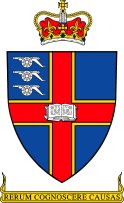Royal Military College of Science
| Royal Military College of Science | |
|---|---|
 | |
| Active | 1772–2015 |
| Country | |
| Branch | |
| Type | Training |
| Role | Teaching of military science |
| Garrison/HQ | Shrivenham |
| Motto(s) | Rerum cognoscere causas (Know the causes of things) |
The Royal Military College of Science (RMCS) was a British postgraduate school, research institution and training provider with origins dating back to 1772.
History
The college traced its history to the Military Society of Woolwich, founded by two artillery officers in 1772 'for the theoretical, practical and experimental study of gunnery'.[1] The Society did not outlast the Napoleonic Wars; but the Royal Artillery Institution was founded, along similar lines, to train artillery officers "for the study of science and languages", in 1840.[2]
In 1864 an Advanced Class for Artillery Officers was formed as part of the Royal Artillery Institution. During the 1880s, the Institution expanded and a commandant was appointed. In 1885 the Advanced Class moved from the Institution into Red Barracks, Woolwich and was renamed Artillery College (but was known as the Ordnance College between 1899 and 1918). After World War I the College expanded and took over the whole of Red Barracks. In 1927 it became the Military College of Science, reflecting its now wider remit.[3]
At the start of the Second World War the college was moved from Woolwich, which was vulnerable to aerial bombing. It moved, initially to the artillery ranges at Lydd in Kent, then scattering to various locations until after the war, when the college was reconstituted and reopened at Beckett Hall in Shrivenham. In 1953, the college was granted its "Royal" title and became the Royal Military College of Science ('RMCS').[3]
In 1984 Cranfield University became the main academic provider of the college.[4] A contract entered into in November 2005 extended the Cranfield relationship to 2028.[4]
Amalgamations

In 2004 the Defence College of Management and Technology ('DCMT') was established bringing together RMCS and the Defence Leadership Centre. Then in 2009 DCMT itself became part of the Defence Academy of the United Kingdom, and was therefore renamed the Defence Academy - College of Management and Technology (DA-CMT).[5]
The college was based, like the majority of Defence Academy institutions, at MOD (Ministry of Defence) Shrivenham, located between the villages of Shrivenham and Watchfield in the south-west corner of Oxfordshire (Vale of White Horse), and had training centres around the country. DA-CMT facilities at Shrivenham were run by Serco Defence. The departments included: Centre for Defence Acquisition and Technology, Centre for Defence Leadership and Management, Defence Centre for Languages and Culture (formerly The Defence School of Languages),[6] Nuclear Department and the Defence Technical Officer and Engineer Entry Scheme (DTOEES).[7]
Since 2015 the College has ceased to exist as a distinct unit within the Defence Academy; its work is continued in several of the constituent units of the Academy, including the Technical School, Nuclear Department, Shrivenham Leadership Centre, Business Skills College and DTOEES.[8]
See also
References
- ^ Skentlebery, Norman (1975). Arrows to atom bombs: a history of the Ordnance Board. London: Ordnance Board.
- ^ "History of the (Royal) Military College of Science" (PDF). Cranfield University. Retrieved 15 August 2018.
- ^ a b "A Short History of the Royal Military College of Science, 1864–1964" (PDF). Retrieved 14 August 2014.
- ^ a b "Cranfield University - Academic Provider to the Defence College of Management and Technology". Retrieved 14 October 2014.
- ^ "A student's guide to Shrivenham" (PDF). Archived from the original (PDF) on 21 October 2014. Retrieved 14 October 2014.
{{cite web}}: Unknown parameter|deadurl=ignored (|url-status=suggested) (help) - ^ "The Defence Centre for Languages and Culture (DCLC)". Defence Academy of the United Kingdom. British Ministry of Defence. Retrieved 17 November 2014.
- ^ "Defence Sixth Form and Undergraduate Training Scheme". Defence Academy. Retrieved 4 December 2016.
- ^ "About us". Defence Academy. MOD. Retrieved 15 September 2016.
